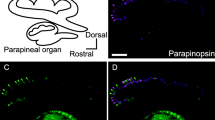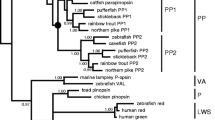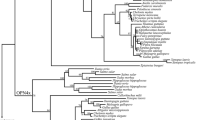Abstract
Non-mammalian vertebrates have multiple extraocular photoreceptors, mainly localised in the pineal complex and the brain, to mediate irradiance detection. In this study, we report the full-length cDNA cloning of ruin lizard melanopsin and pinopsin. The high level of identity with opsins in both the transmembrane regions, where the chromophore binding site is located, and the intracellular loops, where the G-proteins interact, suggests that both melanopsin and pinopsin should be able to generate a stable photopigment, capable of triggering a transduction cascade mediated by G-proteins. Phylogenetic analysis showed that both opsins are located on the expected branches of the corresponding sequences of ortholog proteins. Subsequently, using RT-PCR and RPA analysis, we verified the expression of ruin lizard melanopsin and pinopsin in directly photosensitive organs, such as the lateral eye, brain, pineal gland and parietal eye. Melanopsin expression was detected in the lateral eye and all major regions of the brain. However, different from the situation in Xenopus and chicken, melanopsin is not expressed in the ruin lizard pineal. Pinopsin mRNA expression was only detected in the pineal complex. As a result of their phylogenetic position and ecology, reptiles provide the circadian field with some of the most interesting models for understanding the evolution of the vertebrate circadian timing system and its response to light. This characterization of melanopsin and pinopsin expression in the ruin lizard will be important for future studies aimed at understanding the molecular basis of circadian light detection in reptiles.




Similar content being viewed by others
References
Bailey MJ, Cassone VM (2005) Melanopsin expression in the chick retina and pineal gland. Mol Brain Res 134:345–348
Bellingham J, Whitmore D, Philp AR, Wells DJ, Foster RG (2002) Zebrafish melanopsin: isolation, tissue localisation and phylogenetic position. Mol Brain Res 107:128–136
Bertolucci C, Foà A (2004) Extraocular photoreception and circadian entrainment in nonmammalian vertebrates. Chronobiol Int 21:501–519
Bertolucci C, Wagner G, Foà A, Gwinner E, Brandstätter R (2003) Photoperiod affects amplitude but not duration of in vitro melatonin production in the ruin lizard (Podarcis sicula). J Neurosci 18:63–70
Blackshaw S, Snyder SH (1999) Encephalopsin: a novel mammalian extraretinal opsin discretely localized in the brain. J Neurosci 19:3681–3690
Chaurasia SS, Rollag MD, Jiang G, Hayes WP, Haque R, Natesan A, Zatz M, Tosini G Liu C, Korf HW, Iuvone PM, Provencio I (2005) Molecular cloning, localization and circadian expression of chicken melanopsin (Opn4): differential regulation of expression in pineal and retinal cell types. J Neurochem 92:158–170
Foà A (1991) The role of the pineal and the retinae in the expression of circadian locomotor rhythmicity in the ruin lizard, Podarcis sicula. J Comp Physiol A 169:201–207
Foster RG, Hankins MW (2002) Non-rod, non-cone photoreception in the vertebrates. Prog Retin Eye Res 21:507–527
Foster RG, Garcia-Fernandez JM, Provencio I, De Grip WJ (1993) Opsin localization and chromophore retinoids identified within the basal brain of the lizard Anolis carolinensis. J Comp Physiol A 172:33–45
Grace MS, Alones V, Menaker M, Foster RG (1996) Light perception in the vertebrate brain: an ultrastructural analysis of opsin- and vasoactive intestinal polypeptide-immunoreactive neurons in iguanid lizards. J Comp Neurol 367:575–594
Hattar S, Lucas RJ, Mrosovsky N, Thompson S, Douglas RH, Hankins MW, Lem J, Biel M, Hofmann F, Foster RG, Yau KW (2003) Melanopsin and rod-cone photoreceptive systems account for all major accessory visual functions in mice. Nature 424:76–81
Kawamura S, Yokoyama S (1996) Molecular characterization of the pigeon P-opsin gene. Gene 182:213–214
Kawamura S, Yokoyama S (1997) Expression of visual and nonvisual opsins in American chameleon. Vis Res 37:1867–1871
Klein DC, Moore RY, Reppert SM (1991) Suprachiasmatic nucleus—the mind’s clock. Oxford University Press, Oxford
Koyanagi M, Kubokawa K, Tsukamoto H, Shichida Y, Terakita A (2005) Cephalochordate melanopsin: evolutionary linkage between invertebrate visual cells and vertebrate photosensitive retinal ganglion cells. Curr Biol 15:1065–1069
Minutini L, Innocenti A, Bertolucci C, Foà A (1995) Circadian organization in the ruin lizard Podarcis sicula: the role of the suprachiasmatic nuclei of hypothalamus. J Comp Physiol A 76:281–288
Moutsaki P, Whitmore D, Bellingham J, Sakamoto K, David-Gray ZK, Foster RG (2003) Teleost multiple tissue (tmt) opsin: a candidate photopigment regulating the peripheral clocks of zebrafish? Mol Brain Res 112(1–2):135–145
Okano T, Yoshizawa T, Fukada Y (1994) Pinopsin is a chicken pineal photoreceptive molecule. Nature 372:94–97
Pasqualetti M, Bertolucci C, Ori M, Innocenti A, Magnone MC, De Grip WJ, Nardi I, Foà A (2003) Identification of circadian brain photoreceptors mediating photic entrainment of behavioural rhythms in lizards. Eur J Neurosci 18:364–372
Provencio I, Jiang G, De Grip WJ, Hayes WP, Rollag MD (1998) Melanopsin: an opsin in melanophores, brain, and eye. Proc Natl Acad Sci USA 95:340–345
Provencio I, Rodriguez IR, Jiang G, Hayes WP, Moreira EF, Rollag MD (2000) A novel human opsin in the inner retina. J Neurosci 20:600–605
Roenneberg T, Foster RG (1997) Twilight times: light and the circadian system. Photochem Photobiol 66:549–561
Swofford D (2000) PAUP*. Phylogenetics Analysis using Parsimony (*and other methods). Version 4.0b8. Sinauer, Sunderland, MA
Tosini G, Menaker M (1998) Multioscillatory circadian organization in a vertebrate, Iguana iguana. J Neurosci 18:1105–1114
Tosini G, Bertolucci C, Foà A (2001) The circadian system of reptiles: a multioscillatory and multiphotoreceptive system. Physiol Behav 72:461–471
Whitmore D, Foulkes NS, Strähle U, Sassone-Corsi P (1998) Zebrafish clock rhythmic expression reveals independent peripheral circadian oscillators. Nat Neurosci 1:701–707
Yoshikawa T, Okano T, Oishi T, Fukada Y (1998) A deep brain photoreceptive molecule in the toad hypothalamus. FEBS Lett 424:69–72
Yoshikawa T, Okano T, Kokame K, Hisatomi O, Tokunaga F, Oishi T, Fukada Y (2001) Immunohistochemical localization of opsins and alpha-subunit of transducin in the pineal complex and deep brain of the Japanese grass lizard, Takydromus tachydromoides. Zool Sci 18:325–330
Zatz M (1996) Melatonin rhythms: trekking toward the heart of darkness in the chick pineal. Semin Cell Dev Biol 7:811–820
Acknowledgements
We thank Ignacio Provencio (University of Virginia, USA) for the helpful suggestions for the melanopsin cloning and Cristiano Vernesi (CEA, Trento, Italy) for the assistance in the phylogenetic analysis. This work was supported by funds of the Università di Ferrara to EF and CB and by funds and fellowships from the Max Planck Society and the Centre National de la Recherche Scientifique (CNRS: France) to DV and NSF. NSF participated in a CNRS/Max Planck Society exchange program. The study was performed according to the laws and regulations on animal welfare in Italy.
The two authors, Elena Frigato and Daniela Vallone, contributed equally to this work.
Author information
Authors and Affiliations
Corresponding author
Rights and permissions
About this article
Cite this article
Frigato, E., Vallone, D., Bertolucci, C. et al. Isolation and characterization of melanopsin and pinopsin expression within photoreceptive sites of reptiles. Naturwissenschaften 93, 379–385 (2006). https://doi.org/10.1007/s00114-006-0119-9
Received:
Accepted:
Published:
Issue Date:
DOI: https://doi.org/10.1007/s00114-006-0119-9




